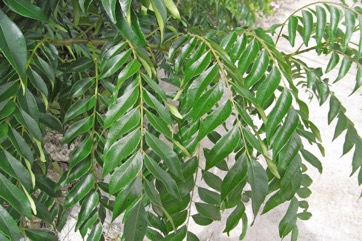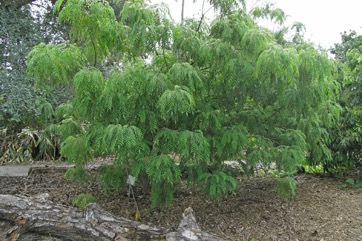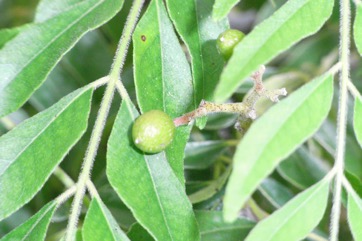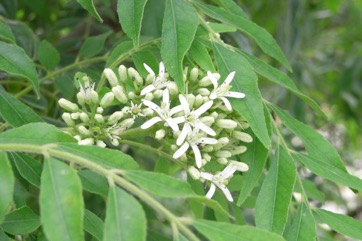Curry-leaf tree

A tropical plant. It grows in the lowlands. It is native to tropical Asia. It grows in clumps in secondary growth and undergrowth in sunny places. It can grow in temperatures between 12°C and 42°C. In Nepal it grows to about 1400 m altitude. In the Himalayas it grows between 800-1,450 m above sea level. It grows in open, dry places. They will not tolerate heavy frosts. It suits hardiness zones 10-12. At MARDI.
Also known as:
Ar-pa-til, Asare, Bai karee, Ban-neem, Barsan, Barsanga, Basango, Bhursunga, Bishahari, Boke, Bokejanu no, Bokraitee, Bowala, Curryblatt, Curry bwlai, Curry patta, Daun kari, Dengjari, Duo ye jiu li xiang, Efinrin oso, Foglio di curry, Gandaela, Gandhela, Gandhla, Gandi, Gandla, Gangela, Gani, Goranimb, Hikandhi faiy, Hikandhi gas, Hoja de cari, Indian bay leaf, Jhirang, Ka li cai, Kadhilimbdo, Kadhi patta, Kadi patta, Kantrok samlor, Kantrook, Kara keeling, Karapincha, Karepaku, Karhinimb, Kari, Kariaphulli, Karibevu, Kari pata, Karipatta, Karipattar, Karivempu, Kariveppilei, Karpoolay, Karupillay, Karuvembu, Karuvepillai, Karuveppilei, Kathneem, Kathnim, Kattuveppilei, Konda karivepaku, Kurry patta, Kyaung-thwe, Ma jiao ye, Mechia sag, Meetha neem, Methonim, Mithhalimb, Mitha-neem, Mitho nim, Mvuje, Nangken nyibumturum, Narashingha, Narasingha, Narasinha, Nolsing, Nwrsing, Phazuvothi, Poospala, Pyi-naw-thein, Pyindaw-thein, Pyin-taw-sein, Salam koja, Sam-khatsi, Surabhininiba, Sweet neem, Tejpatii, Thamsi-youngihabia, Thengsakso, Thenhskso
Synonyms
- Bergera koenigii L.
- Chalcas koenigii (L.) Kurz.
- Murraya foetidissima Teijsm. & Binnend.
Edible Portion
- Leaves, Fruit, Herb, Spice, Vegetable, Flowers
Where does Curry-leaf tree grow?
Found in: Africa, Andamans, Asia, Australia, Bangladesh, Bhutan, Cambodia, China, Cook Islands, East Africa, Fiji, Guyana, Hawaii, Himalayas, India, Indochina, Indonesia, Laos, Malaysia, Maldives, Mozambique, Myanmar, Nepal, Nigeria, Northeastern India, NW India, Pacific, Pakistan, Papua New Guinea, PNG, SE Asia, Sikkim, Solomon Islands, South America, Sri Lanka, Tasmania, Tanzania, Thailand, Tuvalu, United States, West Africa, Zimbabwe
Notes: There are 12 Murraya species. They occur in tropical Asia and the Pacific. It possibly has anti-cancer properties.
Status: The leaves are commonly used in Asian cooking. It is a cultivated food plant.
Growing Curry-leaf tree
Cultivation: Plants are grown from seeds or stem cuttings or root suckers. A spacing of 3.5 m is used.
Edible Uses: The leaves are used to flavour soup and curry dishes. They are also used in chutneys and stews. They are first fried in ghee or oil until crisp, then added to the curry. The leaves are also dried and powdered and used in spice blends. Ripe fruit are eaten fresh. They are peppery. They are used as a spice. Leaves can be sun-dried and stored.
Production: The leaves can be picked about one year after planting. Main production starts after about 3 years. Yields of 2-2.5 kg per square metre are possible.
Nutrition Info
per 100g edible portion| Edible Part | Energy (kcal) | Protein (g) | Iron (mg) | Vitamin A (ug) | Vitamin c (mg) | Zinc (mg) | % Water |
|---|---|---|---|---|---|---|---|
| Leaves | 88 | 9.7 | 2.1 | 93 | 12 | - | 73 |
| Fruit | 108 | 1.2 | 7 | - | 13.4 | - | 64.9 |
Curry-leaf tree Photos




References
Acharya K. P. and Acharya, R., 2010, Eating from the Wild: Indigenous knowledge on wild edible plants in Parroha VDC of Rupandehi District, Central Nepal. International Journal of Social Forestry. 3(1):28-48
Ambasta, S.P. (Ed.), 2000, The Useful Plants of India. CSIR India. p 384
Arinathan, V., et al, 2007, Wild edibles used by Palliyars of the western Ghats, Tamil Nadu. Indian Journal of Traditional Knowledge. 6(1) pp 163-168
Arora, R. K., 2014, Diversity in Underutilized Plant Species - An Asia-Pacific Perspective. Bioversity International. p 105
Bajpai, O., et al, 2015, Tree species of the Himalayan Terai region of Uttar Pradesh, India: a checklist. Check List 11(4): 1718
Bandyopadhyay, S. et al, 2009, Wild edible plants of Koch Bihar district, West Bengal. Natural Products Radiance 8(1) 64-72
Banerjee, A., et al, 2013, Ethnobotanical Documentation of Some Wild Edible Plants in Bankura District, West Bengal, India. The Journal of Ethnobiology and Traditional Medicine. Photon 120 (2013) 585-590
Baro, D., Baruah, S. and Borthukar, S. K. 2015, Documentation on wild vegetables of Baksa district, BTAD (Assam). Scholars Research Library. Archives of Applied Science Research, 2015, 7 (9):19-2
Barwick, M., 2004, Tropical and Subtropical Trees. A Worldwide Encyclopedic Guide. Thames and Hudson p 286
Bohra, N., et al, 2017, Ethnobotany of wild edible plants traditionally used by the local people in the Ramnagar regions from Nainital District, Uttarakhand, India. Biolife 5(1): 12-19
Bremness, L., 1994, Herbs. Collins Eyewitness Handbooks. Harper Collins. p 115
Burkill, I.H., 1966, A Dictionary of the Economic Products of the Malay Peninsula. Ministry of Agriculture and Cooperatives, Kuala Lumpur, Malaysia. Vol 2 (I-Z) p 1531
Burnie, G & Fenton-Smith, J., 1999, A Grower's Guide to Herbs. Murdoch Books. p 28
Cengel, D. J. & Dany, C., (Eds), 2016, Integrating Forest Biodiversity Resource Management and Sustainable Community Livelihood Development in the Preah Vihear Protected Forest. International Tropical Timber Organization p 123
Chandrakumar, P., et al, 2015, Ethnobotanical studies of wild edible plants of Gond, Halba and Kawar tribes of Salekasa Taluka, Gondia District, Maharashtra State, India. International Research Journal of Pharmacy 6(8)
Cheifetz, A., (ed), 1999, 500 popular vegetables, herbs, fruits and nuts for Australian Gardeners. Random House p 139
Chin, H. F., 1999, Malaysian Vegetables in Colour. Tropical Press. p 81
Chowdery, T., et al, 2014, Wild edible plants of Uttar Dinajpur District, West Bengal. Life Science Leaflets. 47:pp 20-36 http://lifesciencesleaflets.ning.com (As Bergera koenigii)
Chowdhury, M. & Mukherjee, R., 2012, Wild Edible Plants Consumed by Local Communities of Maldah of West Bengal, India. Indian J.Sci.Res.3(2) : 163-170
Cundall, P., (ed.), 2004, Gardening Australia: flora: the gardener's bible. ABC Books. p 232 (As Bergera koenigii)
Dangol, D. R., 2002, Economic uses of forest plant resources in western Chitwan, Nepal. Banko Janakari, 12(2): 56-64
Deb, D., et al, 2013, Wild Edible Plants and Their Utilization in Traditional Recipes of Tripura, Northeast India. Advances in Biological Research 7(5):203-211
Dhyani, S.K., & Sharma, R.V., 1987, Exploration of Socio-economic plant resources of Vyasi Valley in Tehri Garwhal. J. Econ. Tax. Bot. Vol. 9 No. 2 pp 299-310
Etherington, K., & Imwold, D., (Eds), 2001, Botanica's Trees & Shrubs. The illustrated A-Z of over 8500 trees and shrubs. Random House, Australia. p 484
Ethnobotany of Karbis. Chapter 4 in p 108
Facciola, S., 1998, Cornucopia 2: a Source Book of Edible Plants. Kampong Publications, p 221
Flora of Pakistan. www.eFloras.org
Foo, J.T.S.(ed), 1996, A Guide to Common Vegetables. Singapore Science Foundation. p 127
Food Composition Tables for use in East Asia FAO http://www.fao.org/infoods/directory No. 488
Gardner, S., et al, 2000, A Field Guide to Forest Trees of Northern Thailand, Kobfai Publishing Project. p 101
Ghosh, C. & Das A. P., 2011, Some useful and poisonous tea garden weeds from the Darjiling District of West Bengal, India. Pleione 5(1): 91 - 114
Hanif, U., et al, 2013, Ethnobotanical studies on some wild plants of head Qadirabad and adjoining areas, Pakistan. International Journal of Phytomedicine 5:373-377
Hedrick, U.P., 1919, (Ed.), Sturtevant's edible plants of the world. p 423
Hibbert, M., 2002, The Aussie Plant Finder 2002, Florilegium. p 199
Hutton, W., 1997, Tropical Herbs and Spices of Indonesia. Periplus. p 29
Hu, Shiu-ying, 2005, Food Plants of China. The Chinese University Press. p 502
Kar, A., & Borthakur, S. K., 2008, Wild vegetables of Karbi - Anglong district, Assam, Natural Product Radiance, Vol. 7(5), pp 448-460
Kar, A., et al, 2013, Wild Edible Plant Resources used by the Mizos of Mizoram, India. Kathmandu University Journal of Science, Engineering and Technology. Vol. 9, No. 1, July, 2013, 106-126
Khan, M. & Hussain, S., 2014, Diversity of wild edible plants and flowering phenology of district Poonch (J & K) in the northwest Himalaya. Indian Journal of Sci, Res. 9(1): 032-038
Kiple, K.F. & Ornelas, K.C., (eds), 2000, The Cambridge World History of Food. CUP p 433
Krishen P., 2006, Trees of Delhi, A Field Guide. DK Books. p 246 (As Bergera koenigii)
Kumar, P. D., et al, 2015, Ethnobotanical Knowledge and Usage of Wild Plants in Theog Forest Division, Himachal Pradesh, North Western Himalaya. The Journal of Ethnobiology and Traditional Medicine. Photon 124(2015) 922-935
Kumar, R. & Saikia, P., 2020, Wild edible plants of Jharkhand and their utilitarian perspectives. Indian Journal of Traditional Knowledge Vol 19 (2), April 2020, pp 237-250
Llamas, K.A., 2003, Tropical Flowering Plants. Timber Press. p 340
Maheshwari, J.K., & Singh, J.P., 1984, Contribution to the Ethnobotany of Bhoxa Tribe of Bijnor and Pauri Garhwal Districts, U.P. J. Econ. Tax. Bot. Vol.5. No.2 pp 253-
Manandhar, N.P., 2002, Plants and People of Nepal. Timber Press. Portland, Oregon. p 326
Martin, F.W. & Ruberte, R.M., 1979, Edible Leaves of the Tropics. Antillian College Press, Mayaguez, Puerto Rico. p 99, 218
Martin, F. W., et al, 1987, Perennial Edible Fruits of the Tropics. USDA Handbook 642 p 75
Medhi, P. & Borthakur, S. K., 2012, Phytoresources from North Cachur Hills of Assam -3: Edible plants sold at Hflong market. Indian Journal of Natural Products and Resources. 3(1) pp 84-109
Medhi, P., Sarma, A and Borthakur, S. K., 2014, Wild edible plants from the Dima Hasao district of Assam, India. Pleione 8(1): 133-148
Morton,
Mozhui, R., et al, 2011, Wild edible fruits used by the tribals of Dimapur district of Nagaland, India. Pleione 5(1): 56 - 64.
Mulherin, J., 1994, Spices and natural flavourings. Tiger Books, London. p 46
Murakami, A. et al, 2014, Screening for the In Vitro Anti-tumor-promoting Activities of Edible Plants from Malaysia. Bioscience, Biotechnology, and Biochemistry, 64:1, 9-16.
Murtem, G. & Chaudhrey, P., 2016, An ethnobotanical note on wild edible plants of Upper Eastern Himalaya, India. Brazilian Journal of Biological Sciences, 2016, v. 3, no. 5, p. 63-81.
Narzary, H., et al, 2013, Wild Edible Vegetables Consumed by Bodo tribe of Kokrajhar District (Assam), North-East India. Archives of Applied Science Research, 5(5): 182-190
Norrington, L., & Campbell, C., 2001, Tropical Food Gardens. Bloomings Books. p 78
Onuminya, T. O., et al, 2017, Comparative proximate and Phytochemical Analysis of leafy vegetables in Lagos State. Nig. J. Pure and Applied Sci. Vol. 30 Issue 3: p 3097f
Oomen, H.A.P.C., & Grubben, G.J.H., 1978, Tropical Leaf Vegetables in Human Nutrition, Communication 69, Department of Agricultural research, RTI Amsterdam, p 36
Omawale, 1973, Guyana's edible plants. Guyana University, Georgetown p 69
Parmar, C., & Kaushel, M. K., 1982, In Wild Fruits. Kalyani Publishers, New Delhi, India. p 45-48
Pasha, M. K. & Uddin, S. B., 2019, Minor Edible Fruits of Bangladesh. Bangladesh J. Plant Taxon. 26(2): 299–313
Patiri, B. & Borah, A., 2007, Wild Edible Plants of Assam. Geethaki Publishers. p 22
Perera, A. H. and Rajapakse, R. M. N., 1991, A baseline study of Kandyan Forest Gardens of Sri Lanka: Structure, composition and utilization. Forest Ecology and Management, 45:269-280
Phon, P., 2000, Plants used in Cambodia. © Pauline Dy Phon, Phnom Penh, Cambodia. p 448
Pradhan, R., et al, 2020, Potential Wild Edible Plants and its Significance in Livelihood of Indigenous People of Male Mahadeshwara Hills, Karnataka. Economic Affairs Vol. 64, No. 4 pp. 01-14
PROSEA handbook Volume 13 Spices. p 278
Purseglove, J.W., 1968, Tropical Crops Dicotyledons, Longmans. p 494
Radha, B., et al, 2013, Wild Edible Plant Resources of the Lohba Range of Kedarnath Forest Division (KFD), Garhwal Himalaya, India. Int. Res J. Biological Sci. Vol. 2 (11), 65-73
Rajapaksha, U., 1998, Traditional Food Plants in Sri Lanka. HARTI, Sri Lanka. p 440
Rao, M. L. S., et al, 2014, Indigenous Plant Foods which are commonly consumed by the tribal communities in Dumbriguda Area of Visakhapatnam District, Andhra Pradesh, India. Biolife. Vol 2, Issue 3
Rashid, A., Anand, V.K. & Serwar, J., 2008, Less Known Wild Plants Used by the Gujjar Tribe of District Rajouri, Jammu and Kashmir State. International Journal of Botany 4(2):219-244
Rasingam, L., 2012, Ethnobotanical studies on the wild edible plants of Irula tribes of Pillur Valley, Coimbatore district, Tamil Nadu, India. Asian Pacific Journal of Tropical Biomedicine. (2012) S1493-S1497
Recher, P, 2001, Fruit Spirit Botanical Gardens Plant Index. www.nrg.com.au/~recher/ seedlist.html p 2
Saikia, M., 2015, Wild edible vegetables consumed by Assamese people of Dhemaji District of Assam, NE India and their medicinal values. Archives of Applied Science Research, 2015, 7 (5):102-109
Sasi, R. & Rajendran, A., 2012, Diversity of Wild Fruits in Nilgiri Hills of the Southern Western Ghats - Ethnobotanical Aspects. IJABPT, 3(1) p 82-87
Savita, et al, 2006, Studies on wild edible plants of ethnic people in east Sikkim. Asian J. of Bio Sci. (2006) Vol. 1 No. 2 : 117-125
Sawian, J. T., et al, 2007, Wild edible plants of Meghalaya, North-east India. Natural Product Radiance Vol. 6(5): p 419
Selvam, V., 2007, Trees and shrubs of the Maldives. RAP Publication No. 2007/12 p 122
Sharma, B.B., 2005, Growing fruits and vegetables. Publications Division. Ministry of Information and broadcasting. India. p 206
Sharma, P., et al, 2013, Wild edibles of Murari Devi and surrounding areas in Mandi district of Himachal Pradesh, India. International Journal of Biodiversity and Conservation. Vol. 5(9), pp. 580-592, September 2013
Shin, T., et al, 2018, Traditional knowledge of wild edible plants with special emphasis on medicinal uses in Southern Shan State, Myanmar. Journal of Ethnobiology and Ethnomedicine (2018) 14:48
Singh, A. G., Panthi, M. P., & Tewari, D. D., 2012, Wild Plants Used as Vegetable in Rupandehi District of Nepal and their Ethnomedicinal Importance. J. Nat. Hist. Mus. Vol. 26, 2012, 111-125
Singh, B., et al, 2012, Wild edible plants used by Garo tribes of Nokrek Biosphere Reserve in Meghalaya, India. Indian Journal of Traditional Knowledge. 11(1) pp 166-171
Singh, H.B., Arora R.K.,1978, Wild edible Plants of India. Indian Council of Agricultural Research, New Delhi. p 31, 78
Smith, A.C., 1985, Flora Vitiensis Nova, Lawaii, Kuai, Hawaii, Volume 3 p 513
Solomon, C., 2001, Encyclopedia of Asian Food. New Holland. p 113
Staples, G.W. and Herbst, D.R., 2005, A tropical Garden Flora. Bishop Museum Press, Honolulu, Hawaii. p 508
Sujanapal, P., & Sankaran, K. V., 2016, Common Plants of Maldives. FAO & Kerala FRI, p 181
Sukarya, D. G., (Ed.) 2013, 3,500 Plant Species of the Botanic Gardens of Indonesia. LIPI p 678
Sundriyal, M., et al, 1998, Wild edibles and other useful plants from the Sikkim Himalaya, India. Oecologia Montana 7:43-54
Sundriyal, M., et al, 2004, Dietary Use of Wild Plant Resources in the Sikkim Himalaya, India. Economic Botany 58(4) pp 626-638
Swaminathan, M.S., and Kochnar, S.L., 2007, An Atlas of Major Flowering Trees in India. Macmillan. p 68
Syst. veg. 2:315. 1825
Teron, R. & Borthakur, S. K., 2016, Edible Medicines: An Exploration of Medicinal Plants in Dietary Practices of Karbi Tribal Population of Assam, Northeast India. In Mondal, N. & Sen, J.(Ed.) Nutrition and Health among tribal populations of India. p 155
Terra, G.J.A., 1973, Tropical Vegetables. Communication 54e Royal Tropical Institute, Amsterdam, p 61
Thaman, R. R, 2016, The flora of Tuvalu. Atoll Research Bulletin No. 611. Smithsonian Institute p 113
Thapa, L. B., et al, 2014, Wild Edible Plants used by endangered and Indigenous Raji Tribe in Western Nepal. International Journal of Applied Sciences and Biotechnology. Vol 2(3):243-252
Tyagi, R. K., et al, 2004, Conservation of Spices Germplasm in India. Indian J. Plant Genet. Resour. 17(3): 163-174
Uprety, Y., et al, 2012, Diversity of use and local knowledge of wild edible plant resources in Nepal. Journal of Ethnobotany and Ethnomedicine 8:16
van Wyk, B., 2005, Food Plants of the World. An illustrated guide. Timber press. p 256
WATT,
Woodward, P., 2000, Asian Herbs and Vegetables. Hyland House. p 98
World Checklist of Useful Plant Species 2020. Royal Botanic Gardens, Kew
http://cookislands.bishopmuseum.org